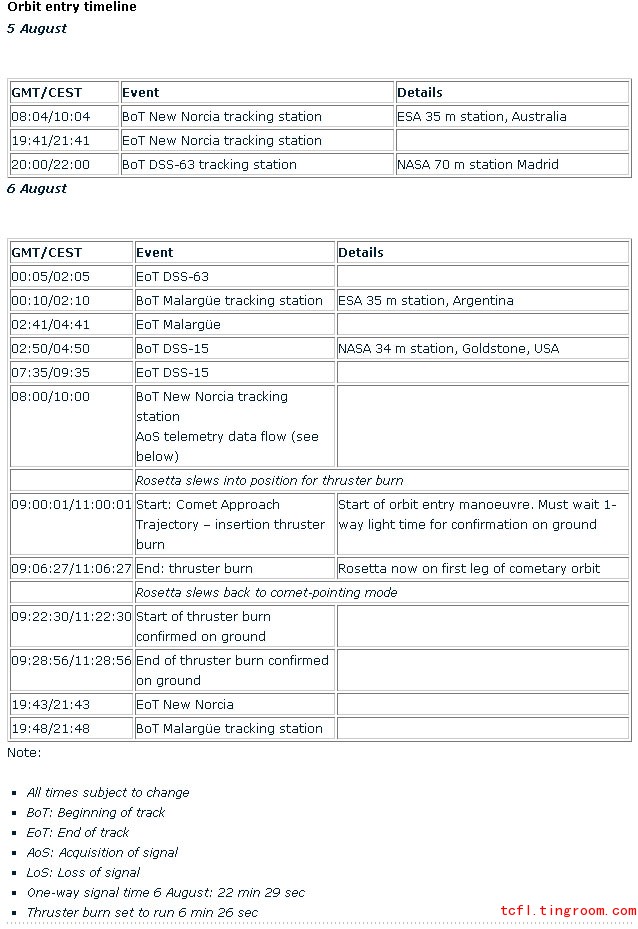After a decade-long journey chasing its target, ESA's Rosetta has today become the first spacecraft to rendezvous with a comet, opening a new chapter in Solar System exploration.
Before long, Rosetta was able to see the comet in the distance, and she took stunning pictures as she got closer and closer. There was only a little way to go now...
+ about Rosetta
Rosetta is a robotic space probe built and launched by the European Space Agency to perform a detailed study of comet 67P/Churyumov-Gerasimenko.
Rosetta launched in 2004 and will arrive at comet 67P/Churyumov-Gerasimenko on 6 August. It will be the first mission in history to rendezvous with a comet, escort it as it orbits the Sun, and deploy a lander to its surface.
Artist impression of Rosetta's signal being received on Earth after 31 months in silent, deep space hibernation. The signal was received at 18:18 GMT/ 19:18 CET by both NASA's Goldstone and Canberra ground stations.
Rosetta is an ESA mission with contributions from its member states and NASA. Rosetta's Philae lander is provided by a consortium led by DLR, MPS, CNES and ASI.
+ about Philae
Philae is a robotic European Space Agency lander that accompanies the Rosetta spacecraft. It is designed to land on comet 67P/Churyumov-Gerasimenko shortly after arrival in 2014.
The lander will achieve the first controlled touchdown on a comet nucleus. The lander is named after Philae Island in the Nile, wher an obelisk was found that was used along with the Rosetta Stone to decipher Egyptian hieroglyphics.
+ about comet 67P
Comet 67P/Churyumov-Gerasimenko is a comet with a current orbital period of 6.45 years which takes it from beyond Jupiter at its furthest point, to between the orbits of Mars and Earth at its closest to the Sun.
Comet 67P/Churyumov-Gerasimenko and Rosetta now lie 405 million kilometres from Earth, about half way between the orbits of Jupiter and Mars, rushing towards the inner Solar System at nearly 55 000 kilometres per hour.
+ Rosetta takes comet's temperature
The first temperature measurements of comet 67P/Churyumov-Gerasimenko were made between 13 and 21 July, when Rosetta closed in from 14 000 km to the comet to just over 5000 km.
The observations were made by the spacecraft's visible, infrared and thermal imaging spectrometer, VIRTIS, and revealed an average surface temperature of -70 degrees Celsius.
This implies the surface is predominantly covered in dust rather than ice, which would yield a lower temperature. The finding does not exclude localised patches of ice. The observations were made when the comet was roughly 555 million kilometres from the Sun.
The comet was roughly 555 million kilometres from the Sun at the time - more than three times further away than Earth, meaning that sunlight is only about a tenth as bright. Although -70 degrees Celsius may seem rather cold, importantly, it is some 20-30 degrees Celsius warmer than predicted for a comet at that distance covered exclusively in ice.
+ How Rosetta arrives at a comet
Rosetta's goal is to match the pace of the comet - currently some 55 000 km/h- and travel alongside it to within just 1 m/s between them, roughly equivalent to a walking pace.
Since early May, Rosetta's controllers have been pacing it through a tightly planned series of manoeuvres designed to slow its speed with respect to the comet by about 2800 km/h, or 775 m/s, to ensure its arrival on 6 August.
+ Countdown to comet arrival
Here is a timeline for you to have a better understanding of the most crucial steps leading to Rosetta��s arrival at its target come.

+ about fabulous fables and tales of tails
Learn about the history of comets with Rosetta and Philae as they hear the fabulous fables and tales of tails from their grandfather Giotto.
+about Rosetta's navigatorsIt would be impossible for Rosetta to reach its destination without the "spacecraft navigators" - the flight dynamics experts who predict and determine its trajectory, prepare orbit manoeuvres and determine its attitude.
The experts work with data from ground stations and from the spacecraft itself to determine the precise locations of Rosetta and its destination comet, feeding this information back to the operations teams who "fly" the missions.
This demands precise, careful work and every calculation is double-checked to ensure the outcome is correct and accurate.
Rosetta's journey to the comet has been assisted by use of the "delta DOR" - for Delta Differential One-way Ranging - technique. Measurements from a pair of widely separated ground stations determine the position of the spacecraft to within less than a few km.



